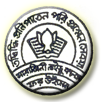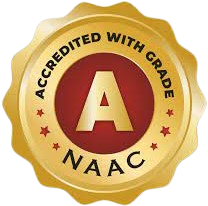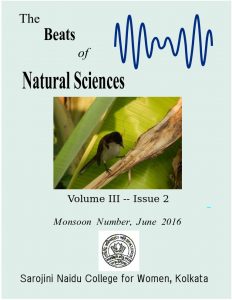ISSN 2348 – 7615
Volume III, Issue 2
Monsoon Number (June), 2016
From the Desk of the Editors:
This is the second issue of the current volume which is supposed to be published within the month of June. But due to various technical problems in our website emerged out from some uncalled for incident, we were forced to reconstruct the webpage of the previous issue. As the University examination process swung into full fledged mode just after that, we had no other option but to wait for another month or so. Anyway this issue is being published as the June issue though it is formally launched just prior to the Nagasaki day.
This issue consists of six articles covering three categories of our journal …
Download pdf: From the Desk of the Editors
Brief reports of original research works:
- Field Emission of High Energy Electrons in 1 + 1-Dimension from the Strongly Magnetized Neutron Star Poles
Sutapa Ghosh and Somenath Chakrabarty [dropdown_box expand_text=”Abstract” show_more=”View” show_less=”Hide” start=”hide”]A formalism for field emission of relativistic electrons in 1 + 1-dimension relevant for strongly magnetized neutron stars / magnetars is developed. In this scenario it has been noticed that the introduction of driving potential in Dirac equation following the conventional form of relativistic quantum hadrodynamic approach, the quantum tunneling or popularly known as the Fowler-Nordheim cold emission of electrons is completely forbidden with both the scalar type or a vector type surface barrier.[/dropdown_box] Download Full Paper
Review on current frontiers or historical milestones:
- Behavioural Ecology of Red-Whiskered Bulbul as Observed Locally in Halisahar, West Bengal, India
Sonali Bhattacharya and Sudipta Majumdar nee Paul [dropdown_box expand_text=”Abstract” show_more=”View” show_less=”Hide” start=”hide”]The observation of the nest-building behavior and parental care of the redwhiskered bulbul was made locally in Halisahar at two different sites, one in between human habitation and the other site, away from habitation. Both the male and female bird took active participation in choosing the site and nest building process. The parental care was very pronounced in these birds. It was observed that the population of red-whiskered bulbul in Halisahar is greater than the adjoining areas. The reason behind this aggregation is yet to be studied.[/dropdown_box] Download Full Paper
- Premature Ovarian Failure : An Overview
Soma Aditya (Bandyopadhyay) [dropdown_box expand_text=”Abstract” show_more=”View” show_less=”Hide” start=”hide”]Premature ovarian failure (POF) is a syndrome characterized by cessation
of follicular-ovulatory function in women under the age of 40. Except for genetic disorders and exposure to high dose radiation or chemotherapy, the precise phenomena underlying the pathogenesis of POF are largely unknown. Although POF was once thought to be permanent, a substantial number of patients experience spontaneous remissions. Hormone replacement therapy remains the cornerstone of treatment, and the best chance of achieving a pregnancy is through oocyte donation. An understanding of basic ovarian embryology and physiology will allow clinicians to develop new innovative therapies for patients with POF. [/dropdown_box] Download Full Paper
- Rice Landraces
Mitu De [dropdown_box expand_text=”Abstract” show_more=”View” show_less=”Hide” start=”hide”]Rice (Oryza sativa L) landraces are most often heterogeneous with a blend of different individual plants maintained by farmers in a local environment and constitute a significant portion of the cultivated rice gene pool in Asia. There is a direct relationship between genetic heterogeneity in crop plants and stable production particularly for resource-poor farmers in marginal environments. These rice landraces are the genetic resources of the agricultural crops that sustain the world’s growing population, and the genetic building blocks for more productive crop varieties. [/dropdown_box] Download Full Paper
The interface — science, environment and society:
- Community -Based Management Approaches : Towards Sustainable Biodiversity Conservation
Supatra Sen [dropdown_box expand_text=”Abstract” show_more=”View” show_less=”Hide” start=”hide”]Community based natural resource management approach combines conservation objectives with the generation of economic benefits for rural communities. A key point underpinning the Community Based models is that local communities have inherent resource management capabilities, and therefore, only the right incentive structure needs to be established. These models represent a significant shift from the State-driven, centralized, technocratic and blueprint approaches that were dominant previously. The catalysts for this change came ‘from above’ (e.g. international donors and the State) as well as ‘from below’ (e.g. communities and social movements). Some believe that the growth of community-based models is `one of the most dramatic transformations in natural resource management in modern history’. The adoption of the Millennium Development Goals – that identified poverty eradication and environmental sustainability as global imperatives – gave further impetus to community-based models. It was felt that it would not be possible to achieve these goals without focusing on the link between environment and poverty and acknowledging the central role of local governance institutions. Community-based models employ three main strategies. They are 1) providing compensation (or substitution); 2) promoting alternative livelihood opportunities; and 3) creating a direct stake in conservation for local people. While the first two approaches support preservation, the third reflects a conceptual shift from preservation to sustainable use.Integrated Natural Resource Management (INRM) is a process of managing natural resources in a systematic way, which includes multiple aspects of natural resource use (biophysical, socio-political and economic) striving to meet production goals of producers and other direct users (e.g. food security, profitability, risk aversion) as well as goals of the wider community (e.g. poverty alleviation, welfare of future generations, environmental conservation). INRM is definitely a major stride towards Sustainable Resource Management seeking to combine economy with ecology.
[/dropdown_box]Download Full Paper
- Towards Awareness of Sustainable Life-Styles : A Comparative Survey Between Urban-Rural Secondary Students
Banani Mitra and Supatra Sen [dropdown_box expand_text=”Abstract” show_more=”View” show_less=”Hide” start=”hide”]Sustainable lifestyles are some distinctive patterns of action and consumption, adopted by people to ensure their basic needs, provide a better quality of life, minimize the usage of natural resources and emission of waste and pollutants over the natural life cycles, and those that do not threaten the needs of future generations. Education can impart the knowledge, skills and behavioural changes that are necessary for mitigation or reducing greenhouse gas emissions through sustainable consumption patterns in lifestyles, livelihoods, economies and social structures that are currently based on excessive greenhouse gas production. The education sector offers a currently untapped opportunity to combat climate change and achieve sustainable development. Education can enable individuals to play a critical role in re-defining their lifestyles to address the current sustainability issues that humanity is facing. Additionally, schools play a role in mitigation in terms of becoming carbon neutral and energy efficient and reducing the students’ ecological footprint. So students with their innovative and creative attitude, can change their own as well as the world’s lifestyle to achieve sustainable development.This paper addresses the awareness and attitude of secondary students of urban and rural areas towards sustainable lifestyle including water pollution, food consumption, fossil fuels and electricity consumption.[/dropdown_box]Download Full Paper
Contact Informations :
| Publisher: Principal, SAROJINI NAIDU COLLEGE FOR WOMEN |
Address: SAROJINI NAIDU COLLEGE FOR WOMEN,30, Jessore Road, Dumdum, Kolkata 700028, India | Phone No.: +91-33-2559 2583 email: info@sncwgs.ac.in |
| Editors: Dr. Sonali Saha Dr. Soma Aditya Bandyopadhyay Dr. Chaitali Biswas |
Address: SAROJINI NAIDU COLLEGE FOR WOMEN,30, Jessore Road, Dumdum, Kolkata 700028, India | Phone No.: +91-33-2559 2583 email:editors.bns@sncwgs.ac.in |
 Pay Your Fees
Pay Your Fees 



